Beginning in 1973, Led Zeppelin, The Rolling Stones, Elton John, Bob Dylan, Alice Cooper, Deep Purple, Peter Frampton, The Allman Brothers, The Moody Blues, Sonny and Cher and Olivia Newton-John used a Boeing 720 plane to tour the US.
This plane, known as The Starship, was converted to remove the rows of passenger seating it had been fitted with in 1959. It was instead fitted with a fully functioning bar complete with an electric organ, a faux fireplace with an electric light to simulate a burning log fire, two televisions and a bedroom.
For four years, this plane was host to parties in the sky featuring sex, drugs and rock and roll as some of the world’s biggest bands travelled between shows. But by 1977, financial problems and wear and tear grounded the plane.
The Starship spent the last years of its life flying as a private jet for businesses and governments before being left to rust in a field at Luton airport in the UK. It was eventually broken up for parts in 1982.
LedZepNews has pieced together this definitive history of The Starship, allowing us to assemble an almost day-by-day account of its activities despite the plane’s flight logs being destroyed by the US government in the 1990s.
We obtained almost 200 pages of Federal Aviation Administration (FAA) records of the plane dating back to the reservation of its tail number in 1958, a copy of the original 1973 brochure that convinced Led Zeppelin to rent the plane and we’ve scoured tour itineraries and dozens of books and magazines to create a comprehensive timeline of the plane’s flights that you can read at the bottom of this article.
You can read the full FAA records on the plane as well as the original 1973 brochure for it here. And we’ve published an investigation here into the mysterious country that rented the plane in February 1979.
Do you have any information you can share about The Starship? We’ve love to hear from you on ledzepnews@gmail.com
1958-1960: Boeing creates The Starship
The earliest surviving record of The Starship’s existence comes in the form of an April 16, 1958 letter from United Airlines vice president of engineering William Cyrus Mentzer to the US Department of Commerce.
In the letter, stored in the FAA’s records of the plane, Mentzer lists 11 tail numbers he’d like to reserve for United’s order of new Boeing 720-022 planes. Mentioned in the list is N7201U, the eventual tail number of The Starship.
With the tail number reserved, Boeing was able to register the plane with the Civil Aeronautics Administration once manufacturing was complete on November 12, 1959.
Painted in a white, black and grey colour scheme with “Boeing 720” on the side in red, the plane had its first flight on November 23, 1959 in Renton, Washington.
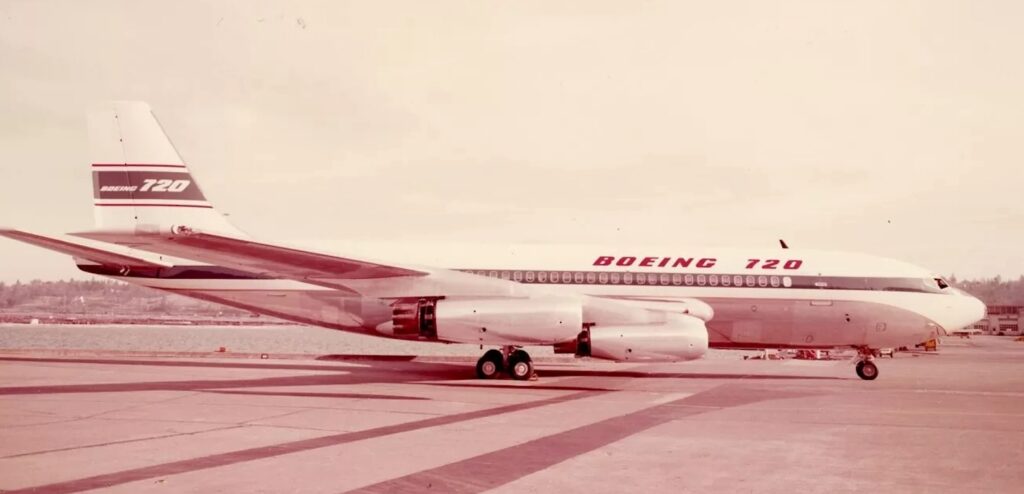
The plane had a series of further test flights in 1960, racking up 296 hours and 38 minutes of flight time by the time it was sold to United Airlines on October 1, 1960.
At this stage in its life, The Starship was called 720 Jet Mainliner Walter T. Varney after the American aviation pioneer who founded a forerunner to United Airlines. Once it received the plane, United repainted it with its white, grey and blue colour scheme and “United” titles on the side in black.

1960-1973: United Airlines

For almost 13 years, The Starship catered to the growing American love of plane travel as part of United Airlines’ fleet of planes. It still wasn’t known as The Starship, instead being renamed 720 Jet Mainliner Capt. F. M. Crismore in 1961.
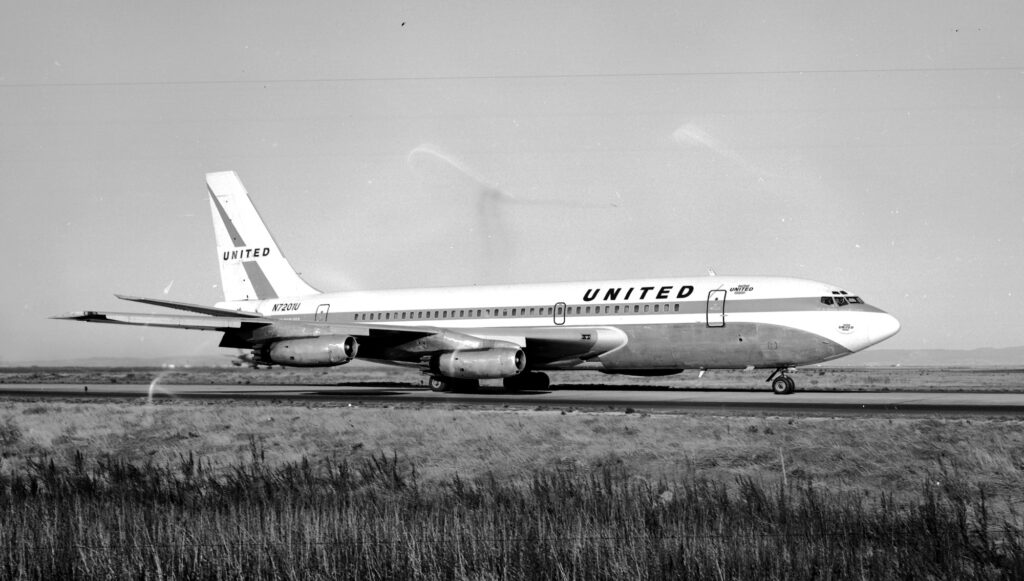
On a flight from San Francisco to Los Angeles, the plane encountered a buildup of static energy.
“It was about 04:00 and all four generators were knocked off line; we were in the dark,” former United Airlines employee Richard Broome recalled in a Facebook post. “It took a couple minutes to get them in phase and back on line.”
“On inspection at dawn at LAXMM there was over a million dollars damage including a big hole on the right side of the radome and chunks blown off all four corners,” he continued. “There was a huge street of melted metal down the ventral fin. It was a miracle that we survived and the trim tab rod was actually welded to the horizontal stab! That was unbelievable and the jet was outta service a month at LAXMM for repairs.”
1972-1973: Contemporary Entertainment Services buys the plane
In 1972, Ward Sylvester had an idea. The film producer and music manager, best known for managing The Monkees and Bobby Sherman, realised that musicians wanted to tour in style instead of crammed into small tour buses.
“A lot of young musicians are making incredible money,” Sylvester told Time Magazine in its April 8, 1974 issue. “But nobody is targeting them as a market.”
“Being on a long flight is like a personal appearance for a performer because he spends the whole time signing cocktail napkins,” he added.
Sylvester set up a new business in Las Vegas with Sherman, the pop singer he managed who was known for his 1969 song “Little Woman”. Together, they incorporated Contemporary Entertainment Services and began lobbying the US government for permission to operate their own airline.
The records of the Civil Aeronautics Board (CAB) show that on August 14, 1972, Syvelster applied to operate a single Boeing 720 plane to transport bands around the US.
He faced almost immediate objections from rival airlines, but was eventually given the green light to operate flights on November 28, 1972. That approval had conditions attached, though: The plane couldn’t leave the US, it was limited to 100 flight hours per year and Sylvester could charge no less than $2,000 per flight hour.
Armed with his approval from the CAB, Sylvester could now buy his plane. Purchase records retained by the FAA show that he signed an agreement with United Airlines on January 15, 1973 to take the ageing Starship plane off its hands for $720,000.
To soften the significant financial blow, which was the equivalent of spending more than $5 million in modern money, Sylvester agreed a loan with Bank of America in the form of a $650,000 promissory note. The Starship was offered as security for the loan, meaning that if Sylvester failed to pay the note off, the plane would be repossessed.

Indeed, this loan would become a serious problem for Sylvester’s dream of ferrying rock bands around the US in style. “The revenues went to paying the note on the aircraft,” he explained in an interview published in the April 2009 issue of Airways magazine.
January-July 1973: The plane is refitted
Sylvester had his plane, so now the hard work began to refit it to be fit for rockstars at a reported cost of $200,000.
Parked at Oakland airport, the rows of passenger seating were ripped out and The Starship was gutted and remodelled by World Air Center using designs created by David E. Bell.
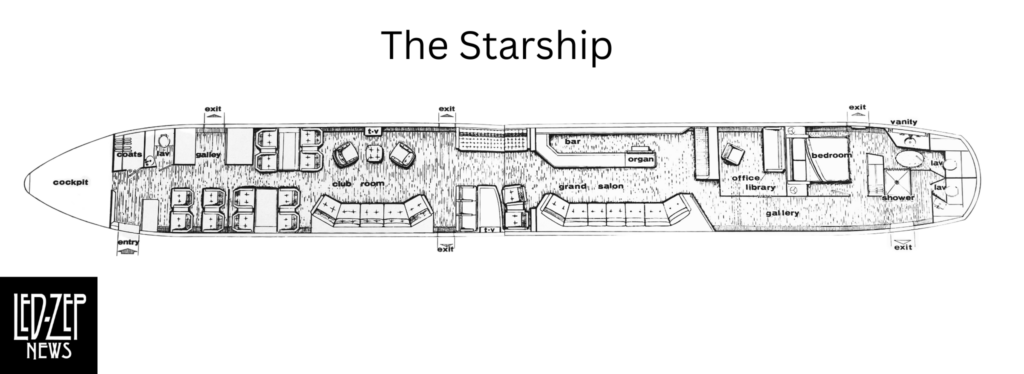
Bell recalled his work on the plane in this article for LedZepNews, explaining the “budget was thin. Real thin. During one lunch meeting at a burger joint, Ward asked the waitress how much the cheeseburger would be if they left off the tomato. Joke or not, that was a precursor for this project.”
“We couldn’t get insane enough for the bedroom,” Bell wrote. “But I found an exorbitantly glitzy wall covering for the bulkheads, and the shaggiest of shag material for the queen bed. Initially, a mirrored headliner above the bed was tried, but since it had to be a plastic mirror, it tended to bend and warp.”
Writing in his 1974 book “Billion Dollar Baby” about his time on the road with Alice Cooper’s band aboard The Starship in 1973, journalist Bob Greene recalled the plane’s interior.
“The first section of the airplane had the look of an elegant private club,” he wrote. “Red wall-to-wall carpeting covered the floor. Against one wall was a long, multi-section couch, covered with an expensive patterned fabric.”
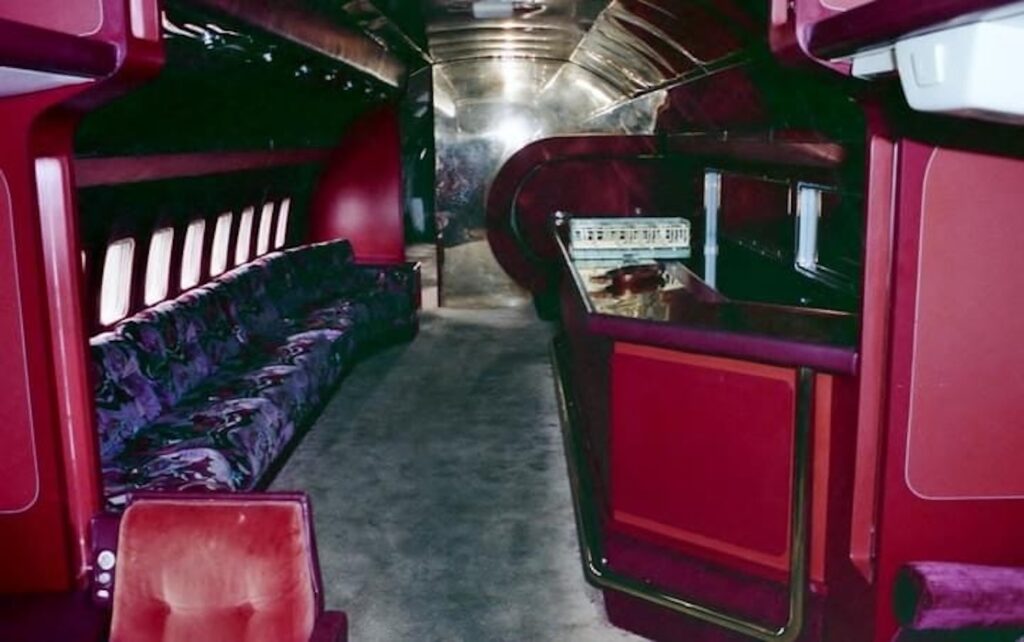
“There were card tables and leather swivel chairs in this compartment; against the wall opposite the couch was a television set, complete with a cabinet full of videotape cassettes … farther back in this compartment were more couches, and a second television set,” he continued.
“The next compartment back was dominated by a long, brass-topped bar,” Greene wrote. “Behind the bar was a butler, who had already laid out a steak-and-salad buffet for us. Beneath the bar, the butler had arranged every conceivable kind of liquor. There were more couches and chaise lounges in this room. Built into the wall were tiny padded hideaways, where passengers could curl up and relax in privacy.”

“At the rear of the plane there was a short hallway, with framed paintings hung on the walls. Two rooms opened off this hallway: a library-study, complete with easy chairs and work tables, and a master bedroom, with a king-size bed and an adjoining bathroom complete with full-size shower,” Greene continued in his book.
“There were no regular seats anywhere on the plane; except for the seatbelts discreetly tucked into the crevices of the couches, there was no sign that we were even on an aircraft. At strategic points along the walls of the plane, white headsets were plugged into stereo outlets; by twisting a dial, we could listen to the program playing on the television, or to our choice of record albums,” Greene added.
FAA records contain a precise day-by-day account of the refit. For example, the water heater previously used to heat up coffee for passengers was repurposed into a heater for the water in the new on-board shower in the plane’s bedroom on March 29, 1973.
Fluorescent lighting was installed in the new bar area on May 10, 1973 and on June 3, 1973, Sony and RCA televisions were installed on the plane along with a Sony tape machine.
The plane was also fitted to include a built-in two-manual stereo Thomas organ in the bar and a mock fireplace in the office/library room, complete with an electric light that gave the illusion of a crackling fire.
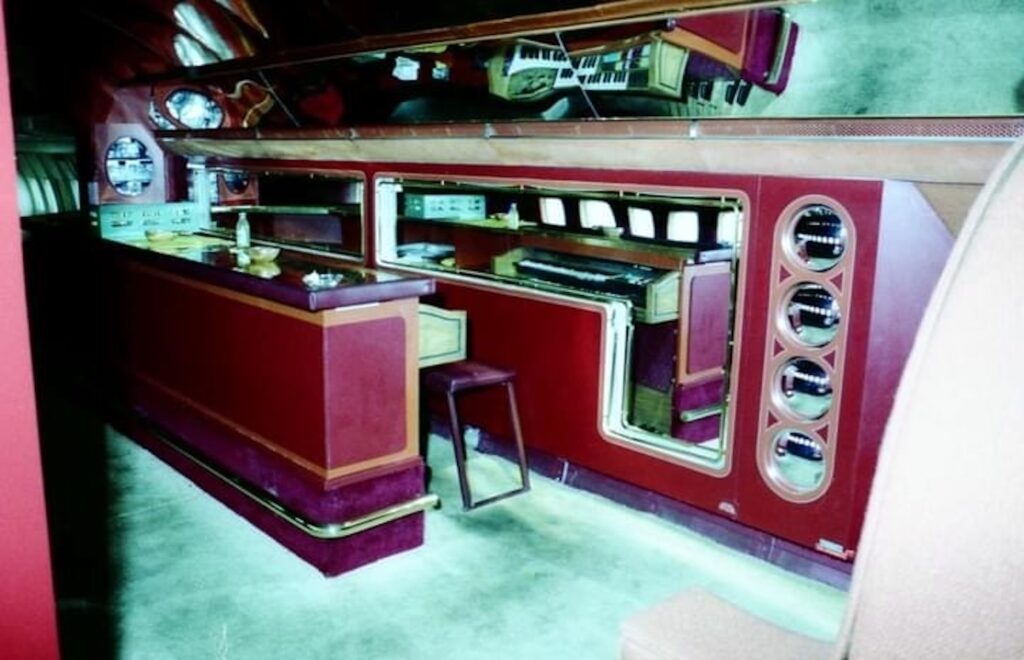
What would happen if a touring rockstar decided to use the organ while also watching a video on both televisions with the mock fireplace turned on? Thankfully, the engineers checked this exact scenario to make sure the plane’s electrical circuits wouldn’t be overloaded. They also carried out ground and flight tests to ensure the video and televisions wouldn’t cause interference with the plane’s cockpit.
A brochure produced to market the plane to rock bands in 1973 explains the design. “Inside Starship I is a richly private world far removed from ordinary air travel,” it explains. “Every imaginable amenity has been incorporated to transport up to 40 persons in penthouse-like luxury heretofore available only to heads of state.”
To reflect the plane’s luxurious interior, the outside of the aircraft was also reworked. It was given a gold and brown colour scheme with its new name “Starship I” inscribed in white text below the cockpit.
To entertain guests on board the plane, it was equipped with packs of cards and a backgammon board along with videotapes of films such as the 1972 pornographic movies “Deep Throat”, “Medallion”, “Give Me A Sailor” and “Behind the Green Door” along with 1965’s “Hot Rocks” and the considerably less pornographic 1933 Marx Brothers film “Duck Soup” and the 1941 film “The Maltese Falcon”.
Roaming rock bands not wanting anything too taxing as they recovered after shows had a series of black and white Flash Gordon films to enjoy including 1938’s “Rocket Ship” and “Mars Attacks the World” and the 1966 film “Purple Death from Outer Space”. Other science fiction tapes on offer included 1958’s “The Fly” and the 1963 film “The Day Mars Invaded Earth”.
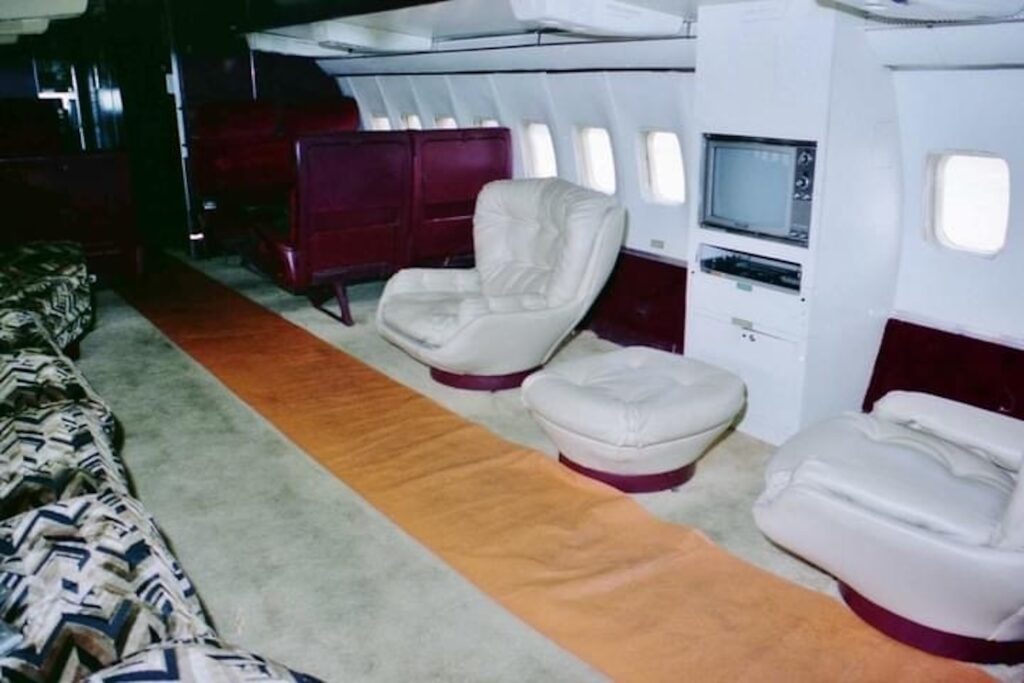
For musicians keen to check out their competition, the plane also had a videotape of Paul McCartney’s April 1973 TV special “James Paul McCartney”. Slightly less contemporary was the 1956 musical “Don’t Knock the Rock” featuring Bill Haley & His Comets.
According to Richard Cole, writing in his 1992 book “Stairway to Heaven: Led Zeppelin Uncensored”, the plane’s bar was stocked with “plenty of champagne, beer, wine, Scotch, Jack Daniels, and gin. The belly of the plane was crammed with cases of Dom Perignon (1964 and 1966 vintage) and Singha beer.”
Food and drinks were served on “Waterford crystal, Reed and Barton silver and gilded Noritake china”, Time magazine reported. Visiting British bands could be served “Irish ale and a stock of their favorite Dunhill and Rothman cigarettes,” Time added.
“It was quite spectacular,” Atlantic Records executive Phil Carson said in Mick Wall’s 2008 book “When Giants Walked the Earth”. “Inside, the whole layout was decadent and totally over the top.”
“There was even a fireplace; a glowing electric pseudo coal fire. The bed actually had seatbelts on it so you could take off and land in a horizontal position. I don’t recall anybody did that but that aircraft got a lot of use,” Carson said.
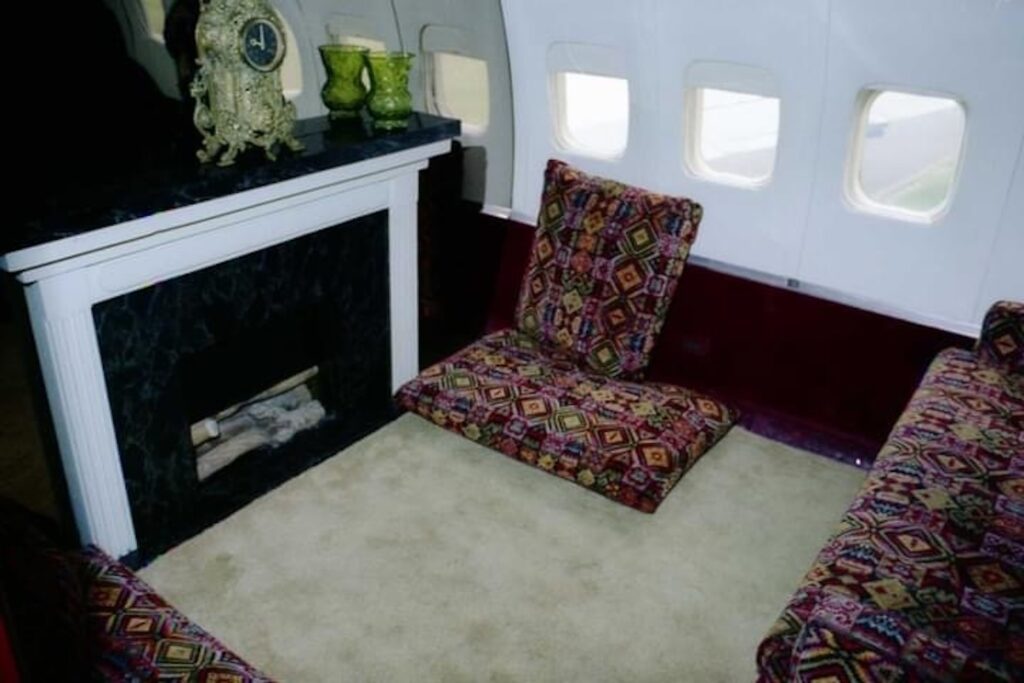
Sylvester had hired a crew for the plane who were trained to treat their customers well. Suzee Carnel, the blonde, 18-year-old sister of Sherman’s wife Patti, was hired as a stewardess along with 22-year-old Bianca who had dark hair.
Other stewardesses who worked on the ship included Sandy Cronin, who explained to Time that “at first some people thought we came with the day rate. But all in all, the guys in the rock groups are better to serve than drunken businessmen,” and Candy Burton. John Ross was employed to man the plane’s bar.
The plane was flown by two pilots: Hal “Mac” McNicol, who had spent four years in the US Navy during the Second World War, and Tony Martineau.
With the refit complete and the staff hired, the plane underwent two rounds of inspections on June 22 and July 11, 1973. It was cleared to return to service, ready for its first musical customer.
“After the interior was finished and the exterior painted, the plane was flown to Los Angeles,” Bell wrote in his article. “The plane was parked in the corporate aircraft area where Ward dreamed up a crazy ‘open house’ of sorts. And it was crazy! A long red carpet lined with potted palms led to the stairs to the plane’s front door. Ward’s big white Chrysler Imperial was parked on one side and a black Mercedes limo on the other.”
“The rock world flocked aboard. I didn’t recognize several groups at the time, but The Monkees, who Ward managed, were there with many others. There was so much weed consumed that I was getting a heavy contact high and had to go outside for real air,” Bell wrote.
“While trying to stand outside, a corporate Gulfstream taxied in and parked nearby. I had designed the interior and paint for the owner, Baron Hilton, and after they deplaned, they headed for the Starship. I became frantic. If they saw me loaded, and saw Ward’s crazy wild interior, I might never get to do another plane for them. But they insisted to see what was going on, so I led them aboard. They didn’t stay long, and no, I was never able to get another job with them.”
July 1973: Led Zeppelin boards The Starship
Led Zeppelin had grown sick of renting nine-seater Falcon planes for touring by the time the band returned to the US for the second leg of its 1973 US tour. Peter Grant, the band’s manager, had ordered tour manager Richard Cole to find a larger plane for the remainder of the tour, Cole recalled in his 1992 book.
Grant’s request was prompted by a turbulent flight from San Francisco to Los Angeles in June 1973, right at the end of the first leg of the 1973 tour. “I’ve had it with these fucking little planes! This is the last time we fly them. The last time,” Grant exclaimed during the flight, according to Cole’s book.
“We’ve got a month’s hiatus coming up in the middle of this tour. By the time the tour resumes, I want us to have a bigger plane. I don’t care what it costs. Get us something so big that it won’t seem like flying at all,” Grant ordered Cole.
Cole spent the month of June 1973 searching for a larger plane that would be ready for Led Zeppelin’s return to the US the following month.
“I contacted Lou Weinstock of Toby Roberts Tours, who used to arrange for planes for Elvis. Lou passed on a brochure to me about a Boeing jet called the Starship,” Cole recalled in his book.
“It was a 720B—a forty-seater that had been customised specifically for rock stars, although no one had yet taken a long-term lease on it. Frankly, I doubted that anyone could afford it.”
Mark London, a composer and music manager connected to the band, claimed he inspected the plane at Newark Airport along with Led Zeppelin’s lawyer Steve Weiss, eventually agreeing a deal for Led Zeppelin to become the first customers of The Starship, renting the plane for $30,000 for three weeks. The band’s name was painted on the side in brown text.
Led Zeppelin showed off the plane by inviting a film crew on board as they prepared to fly from New Jersey to Seattle on July 17, 1973.
The band used the plane for a new method of touring, basing the band members in hub cities such as New York, Los Angeles, Chicago, New Orleans, Miami and Dallas and then flying them out to play shows around the US, often flying back to their current “home” city immediately after the show.
There was no need for the band to hire tables in restaurants or hotels, either, with specially requested Thai food served on board the plane on the way to and from shows.
Pleased with scoring one of the world’s biggest bands as his first client, Sylvester informed Cash Box for its July 21, 1973 issue that despite his plane being “just completed two weeks ago”, it was already being used to ferry Led Zeppelin around the US.
Sylvester’s business, the article added, “is currently finalizing negotiations to provide similar tour services for three other major performing groups, to be announced shortly.”
Led Zeppelin ended its 1973 US tour by basing the members at the Drake Hotel in New York in late July. The band checked into the hotel on July 24, 1973 before driving to either Newark or Teterboro Airport where they posed for photos beside the plane on the runway.
Eventually, they boarded The Starship along with Atlantic Records executive Ahmet Ertegun for a flight to Pittsburgh to play in the city that evening, flying back to New York hours later which would be the band’s final flight on The Starship until 1975.

1973: A flying tour bus
The second customer to rent the plane was Elton John for his 1973 US tour. The plane was repainted to remove Led Zeppelin’s name, replacing it with “Elton John – 1973 Tour”. Contemporary Entertainment had also been given permission to fly the plane to Canada, expanding the range of tour stops it could handle.
From August to October 1973, the plane ferried John’s band around the US. It also played host to his famous friends. On September 25, 1973, Stevie Wonder was brought on board without John’s knowledge for a flight from New York to Boston. John was simply told his managers had hired a pianist for the flight, not realising it was his friend.
Wonder boarded the plane before John and had a tour of the jet with Ira Tucker who “guided Steve’s hands over the fireplace”, Esquire reported in its April 1, 1974 issue.
“I thought you were putting me on. Those logs real? Do they burn? Oh, this is too much,” Wonder said, before being served a French 75 made with Moët & Chandon and Courvoisier.
John arrived to board the plane, still not realising the person playing his song “Crocodile Rock” on the organ was Wonder.
“Unbeknownst to Elton, who had retreated to the bedroom in the rear of the plane, Stevie Wonder flew from New York up to Boston for the concert that evening. Elton had to be coaxed out to witness the Motown superstar playing a medley of Elton’s hits on the Starship’s organ,” an article on John’s website reads.
The plane was also used by The Allman Brothers Band following the August 1973 release of their landmark album Brothers and Sisters.
“When the Allman Brothers got that goddamn plane it was the beginning of the end,” Greg Allman wrote in his 2012 autobiography “My Cross to Bear”. Like Led Zeppelin, the band leased the plane through Toby Roberts Tours.
“The first time we walked on to the plane ‘Welcome Allman Brothers’ was spelled out in cocaine on the bar,” Allman recalled in his 2012 book.
The plane was becoming so famous that it was newsworthy in its own right. MGM hired The Starship in September 1973 to fly journalists from Los Angeles to San Francisco as part of the launch of its new singer Judi Pulver’s debut album. The record label even hired astronaut Edgar Mitchell, the sixth person to walk on the Moon, to join the flight as a tenuous link with Pulver’s new single “Dancing On The Moon”.
Carnel, the 18-year-old stewardess, spoke to journalists on the flight, confessing that “her fondest wish is for the Moody Blues to lease the jet next,” Record Week reported in its September 8, 1973 issue, noting that Carnel “survived Led Zeppelin” on the plane and was “surely one of its most delightful passengers”.
Despite the lavish launch event, Pulver’s album flopped. “When the evening was over, the inevitable truth set in. Judi Pulver just couldn’t carry the hype,” Newsweek reported in its October 27, 1975 issue.
Carnel would get her wish weeks later, however, when The Moody Blues rented the plane at the end of October.
“There were just the five of us, and we had about five people flying the plane, and we had our own butler, and we had our own person playing this organ. And I remember walking from the front [of the plane] to go to the restroom at the back, to the toilet,” band member John Lodge recalled in an interview with the radio show “In The Studio” broadcast on September 30, 1991.
“I walked past the organist playing, and I walked past the barman making some drinks, and then I walked past this sort of sitting room area with a fireplace, I walked past two bedrooms. I went to the toilet, and I was in there, and I thought … I’d never been so lonely in my life!”
“It was like walking … down this huge tunnel of nothing. But, you know, materialism and wealth, and everything else, what we’d bought, what we’d chartered. I suddenly realised I got back and there was just the five of us, sitting at the front, just talking about absolutely nothing. We’d just lost all the art of conversation, because we’d been together so much. And I thought, ‘Well this is ridiculous. I don’t really want to be on this plane.’”
The rental of the plane by The Moody Blues followed another short-term rental by Sonny and Cher, with the plane spotted in Los Angeles emblazoned with their logo as part of a deal to fly the pair in to perform twice at the Tennessee State Fair on September 15, 1973.
Another early customer of the plane was Alice Cooper, who rented it in December 1973 but ended up switching to smaller planes because of continued delays caused by cold weather.
Writing in his 1974 book, Greene recalled Cooper’s first flight on The Starship on December 10, 1973 as the band flew from Piedmont to Madison. “The butler hurried around the interior of the plane, going from person to person. He carried a silver candy dish, filled with cellophane packets containing daily rations of multi-colored vitamin pills.”
“A stewardess walked out into the middle of the club room compartment,” Greene continued. “She was wearing Levi’s and a polo shirt. ‘Hi,’ she said. ‘I’m Sandy. I’m only going to say it once, because it’s boring. But here it is—no sitting in the swivel chairs during takeoff or landing. The same goes for the bedroom or the sitting room. Otherwise, the plane’s yours. Enjoy it.’”
“Sandy walked over to the television and plugged in a cassette. There was a flickering on the screen, and then the opening scenes of ‘Deep Throat’ appeared. We sped down the runway, and up into the air, just as Linda Lovelace was giving the first demonstration of her oral dexterity.”
The band returned to the plane for a December 12, 1973 flight from Madison to Ann Arbor. The extreme cold caused problems for The Starship, however.
“When we arrived at the airport, we found that the engines on the Starship had not been started, and when we got inside the plane, we learned that there was no heat,” Greene wrote. “We kept on our overcoats, and covered ourselves with blankets, and as we talked to one another on the couches and lounge chairs, our breath was visible in the air.”
“One of the jet valves is frozen up,” Carnel the stewardess reportedly told passengers. “It’s too cold for us to take off yet. Everything’s frozen tight. It’s the first time the plane has been in cold weather.”
1974: More bands use The Starship
The first artist to use the plane in 1974 was Bob Dylan, who paid $20,000 for the plane and requested that his name wasn’t displayed on the side of the aircraft. The side of the plane was instead painted with a blank rectangle to cover up Alice Cooper’s name.
Beginning on January 3, 1974, The Starship carried Dylan and The Band around the US until the following month. But record label boss David Geffen quickly admitted that the hiring of The Starship for Dylan’s tour was a bad idea.
“Well, frankly it was a mistake,” he said, according to an article published in the January 31, 1974 issue of Rolling Stone. The plane had the capacity for 40 people, but Dylan travelled with just the members of The Band, meaning only seven passengers were on board.
“We just didn’t know how many people were actually coming,” Geffen explained.
Despite the slimmed down tour, Dylan contributed to the plane’s alcohol stores by stocking it with bottles of 1964 Château Mouton Rothschild wine, according to an article in the April 15, 1974 issue of The New Yorker. He also ensured his favourite vegetable casseroles were served on board.
Along with Dylan’s wine supplies and casseroles, The Starship had also been given an expanded food menu for 1974. “Starship, I, the jetliner for the stars, now has means to suit nearly any taste. The new line-up includes French cuisine, hot dogs, hamburgers, and even organic food,” the January 26, 1974 issue of Cash Box reported.
In March 1974, it was Deep Purple’s time to enjoy The Starship. Unlike Dylan, the band had its name painted on the side of the plane as it toured the US for a month.
“On regular airlines, there are always queues for flights, overbooking, lost luggage and canceled connecting flights. This tour already has less frantic a feel,” band member Jon Lord told Time Magazine.
“It’s supposed to look as little as a plane as possible,” he said of the plane in an interview with Circus magazine published in its October 1974 issue.
The band made full use of the plane’s facilities, inviting the press on board and throwing a midair party as The Starship flew from San Diego to Los Angeles following the final show of the tour leg on April 9, 1974. The party was designed “to finish off all the undrunk champagne and to say goodbye to the roadies,” NME reported in its April 27, 1974 issue.
Deep Purple even used the plane to write songs, or at least to find existing ones. Writing in his 2011 autobiography “Glenn Hughes: The Autobiography”, band member Glenn Hughes recalled how Deep Purple came up with their 1974 song “Love Don’t Mean A Thing”.
“Ritchie [Blackmore] found a busker in Chicago on the street, got him on the Starship and flew him down, and on the way he sang a song about money,” Hughes wrote. “Ritchie called me and David [Coverdale] into the library on the Starship and said ‘We should do something with this song’ and I think we paid the guy some money.”
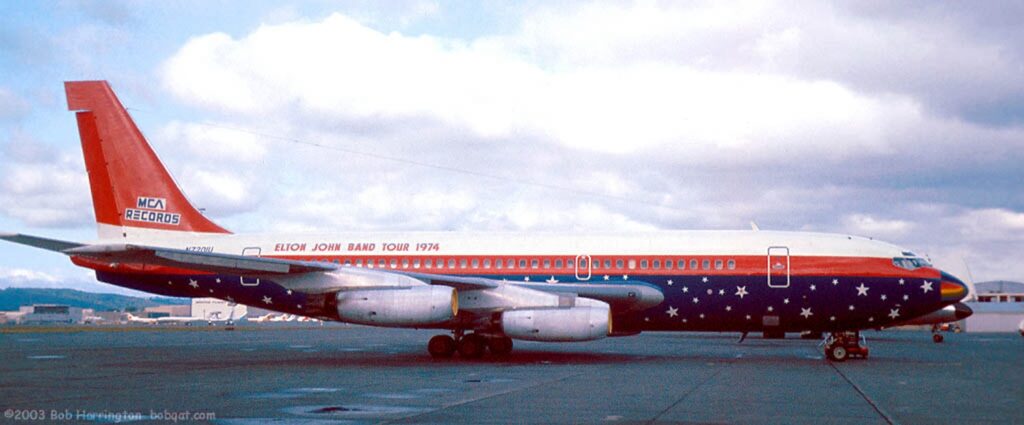
Ahead of Elton John returning as a client in September 1974, The Starship was given a radical paint job. The gold and brown colour scheme was gone, replaced with a bold white, red and blue design complete with white stars on the underside of the plane and a red, yellow, green and blue rainbow design on the plane’s nose. And for John’s second time on board, the plane was painted with “Elton John Band Tour 1974” on the side in red text.
Just like before, The Starship became a travelling party venue for fellow celebrities. John Lennon flew on the plane in November 1974 alongside John and his band as they travelled from New York to Boston.
“The former Beatle had yet to attend an Elton John concert and wanted to see what he was getting himself into since he would be joining Elton on stage at Madison Square Garden the following evening in fulfillment of a bet he ‘lost’ by having his ‘Whatever Gets You Thru The Night’ top the Billboard singles chart,” John’s website explains. Lennon’s eventual surprise appearance in New York on November 28, 1974 would be his last stage performance.
Deep Purple rented the plane for a second stint in November and December 1974. Hughes brought his drug dealer along on the plane with him, he recalled in his autobiography.
The brand also brought photographer Fin Costello on board on December 1, 1974 as they posed with gold records, with Coverdale sitting in the plane’s cockpit.
1975: The return of Led Zeppelin
Led Zeppelin’s 1975 US tour was designed as an all-out assault on the world’s most lucrative nation for touring. Pleased with their use of The Starship in 1973, the band hired the plane again from January to March 1975.
Speaking to the New York Times Magazine in 2003, stewardess Carnel recalled an incident with Led Zeppelin drummer John Bonham on the plane. “He once tried to open the plane’s door over Kansas City because he had to pee,” she said.
John Paul Jones, the band’s bass and keyboard player, was a quieter presence on board. His tour exuberances seemed only to stretch to playing “I’ve Got a Lovely Bunch of Coconuts”, “Any Old Iron” and “Bye Bye Blackbird” on the plane’s organ to amuse the other passengers.
An early hiccup came on the night of January 24, 1975 when a blizzard hit Cleveland as the band planned to fly back to Chicago for the night. Private planes could still choose to take off, but The Starship’s pilot was unwilling to risk it. “We’ve got to go, we’re going to Chicago” Grant urged the flight crew, according to Bob Spitz’s 2018 book “Led Zeppelin: The Biography”.
Joe Jammer, an associate of the band, recalled in the book what happened next. “Peter pulled out a mirror, took a gram of cocaine, laid it down in one line, and stuck it under the pilot’s nose. The pilot snorted the whole fucking line.”
“Okay, we’re ready to go to Chicago,” the pilot then announced, according to Spitz’s book.
A series of journalists was invited on the plane to cover the tour, including Stephen Davis who covered the tour for The Atlantic, NME’s Nick Kent and Melody Maker’s US editor Chris Charlesworth.
During flights, Page and Grant typically kept themselves contained at the back of the plane, Charlesworth tells LedZepNews. “[John Paul] Jones was playing backgammon with security guys and Bonham was asleep,” he says.
Being a journalist on board Led Zeppelin’s plane had its perks. “Peter Grant asked me if I wanted to see the cockpit, so I said yes and off we went,” Charlesworth recalls of a late January 1975 flight on The Starship from Chicago to Los Angeles.
“I sat behind the two pilots for a little while, then one of them asked if I wanted a go at flying it. So I moved into that pilot’s seat and got hold of the joystick. He told me to bring it towards me and the plane would rise in the sky, then push it away and it would go back down, so I did that once or twice.”
“You could see the movement of the plane on a small screen in the banks of controls between the two pilots’ seats. I remember the huge panoramic view of the light blue sky ahead of us, on top of the clouds which were white and fluffy below, and in the distance you could just make out a few other planes, miles and miles away. It was so still you didn’t really appear to be moving,” Charlesworth continues.
Once back in his seat, Grant claimed to the journalist that Bonham had once flown the plane from New York to Los Angeles.
Bonham had been asleep during the journey, but then “emerged from the bedroom dressed only in a loosely-fitting red bathrobe,” Charlesworth writes in his upcoming memoirs about his time on the road with Melody Maker, titled “Just Backdated: Melody Maker: Seven Years In The Seventies”.
“Unseen until too late, he lurched drunkenly into us and, without even having been introduced, propositioned one of the stewardesses by lifting up her skirt at the rear and forcing her to the ground in a clumsy attempt to mount her from behind.”
“Grant and Cole wrenched Bonzo away from the shocked girl and led him struggling back towards the bedroom. The girl’s screaming alerted a pilot who appeared from the cockpit, demanding to know what was happening. He was very angry. The girl was sobbing,” the book continues.
“I don’t wanna see one fuckin’ word of this finding its fuckin’ way into your fuckin’ magazines. Right,” Cole, Led Zeppelin’s tour manager, then told the journalists on the plane, Charlesworth writes in his book.
Another incident occurred on the night of January 31, 1975 as the band flew back to New York from a show in Detroit earlier that evening. Music promoter Danny Marcus was along for the ride.
“With no warning, [Bonham] reached over and grabbed Marcus’ eyeglasses off his totally shocked face,” Davis wrote in his book “LZ-’75”.
“The Beast broke the glasses in half and ground them into the orange shag carpet with his boot. Then, without a word, John Bonham got up and walked to the back of the plane.”
Despite these incidents, the tour continued. On March 10, 1975, it was natural forces rather than the temper of Bonham that caused problems. As The Starship flew from Los Angeles to San Diego, a thunderstorm occurred.
With “Teddy Bear” by Elvis Presley playing on the plane’s speakers, the aircraft lurched around in the sky. “Robert Plant stayed cool. He remarked that if the Zeppelin was going down, the Elvis sound track was totally appropriate since Elvis was where Led Zeppelin had come from,” Davis wrote in his book “LZ-’75”.
1975: The Rolling Stones join the party
After a few weeks of use by John Denver in April and May 1975, with his name painted on the side of the plane, The Starship was repainted with two of The Rolling Stones’ tour eagle designs on the side, “one already peeling”, according to the July 17, 1975 issue of Rolling Stone. From June to August 1975, the Stones used The Starship as their tour plane.
Inside the plane, the band had tacked up a map of the US on the wall next to the bar with their tour stops highlighted.
The crimson interior with white rotating seats wasn’t to everyone’s taste. “Inside it is the personification of vulgarity in a marvellous way,” Christopher Simon Sykes wrote in his tour diaries, published in his 2016 book “T.O.T.A. ’75: The Rolling Stones Tour of the Americas, 1975”
“As Mick said, ‘It’s so tacky it’s great,’” Simon Sykes continued. Jagger seemed to enjoy the plane, despite its interior. While the plane was in Kansas on June 6, 1975, he took the opportunity to play the bar’s organ with percussionist Ollie Brown, photos taken at the time show.
“We had a private Boeing 720, dubbed Starship, that came complete with a bedroom, a lounge, a library, showers, a bar with an organ and, occasionally, naked girls running up and down the aisles,” band member Ronnie Wood recalled in his 2007 autobiography, “Ronnie”. “It was the first time I’d ever travelled in that kind of luxury. We’d get picked up on the tarmac and whizzed off to the hotel in a fleet of cars, police escort in attendance.”
Simon Sykes travelled on the plane during the tour, keeping a diary of what he saw. “When I board there is a rush for seats around the video machine to watch any one of a strange selection of films,” he writes of a June 9 flight to St. Paul in his book.
“Then the food arrives and the stewardesses are trampled under foot in the ugly battle that ensues over apple pie (‘a must’, orders a memo, ‘make sure it’s always there’), or even roast beef, hamburgers, fried chicken, veal escalopes, Chateaubriand, fresh cheese, peaches, grapes, melons, strawberries,” his diaries continue.
“The bar is open at all times offering Tequila, Jack Daniels (‘must be in stock at all times’) Kahlua and milk, French wines, Remy (‘in dark smoked bottle’), Vodka, etc and tea (‘must be good tea as this is popular’). For those who are still not satisfied there is always backgammon, cards, assorted cigarettes, magazines, etc.”
The ample supplies of food on board came in handy for a flight in the early hours of the morning of June 19, 1975 as the band made its way from Toronto to New York.
“More high jinx on the plane involving Mick throwing a bowl of fruit salad at the Commander and soon all manner of things are flying. To many people it might seem immature and childish but it is a good way of letting off steam,” Simon Sykes wrote in his book.
In early July, the plane was hit with a thunderstorm as the band flew from Washington DC to Memphis. “The storm lasted an hour and tossed us all over the sky, and the turbulence was so horrible that Bobby Keys nearly went through the roof of the plane,” Wood recalled in his book. “All of us thought our number was up.”
Keith Richards recalled the same bumpy flight in his 2010 book “Life”. According to Richards, the plane dropped suddenly “many thousands of feet, with much sobbing and screaming, the photographer Annie Leibovitz hitting her head on the roof and the passengers kissing the tarmac when we landed.”
“I was seen going to the back of the plane and consuming substances with more than usual dedication as we tossed about the skies, not wanting to waste,” Richards continued. He and Wood drove from Memphis to the next show in Dallas instead of risking the plane again.
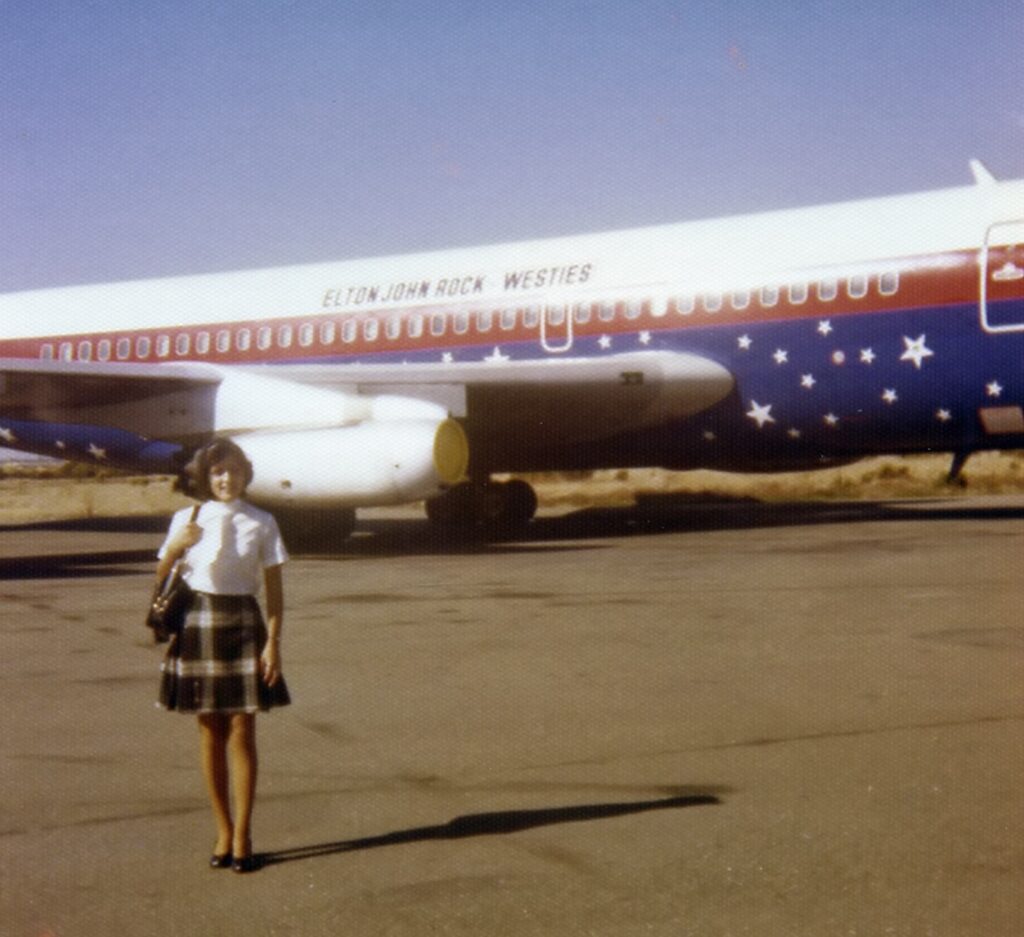
Later on in 1975, the plane was again used by Elton John and given the titles “Elton John Rock Of The Westies” on its side until October. From November to December, The Allman Brothers Band returned to The Starship.
1976: Elton John and Peter Frampton
The final year of The Starship’s operation as a flying tour bus for rockstars began with a slightly less rock and roll client: Olivia Newton-John. The pop star’s name was written on the side in curling black font.
Until now, The Starship had been limited to flying around the US and Canada, but its operator had been given permission to travel to Europe. With the price of oil still high following the 1973 oil embargo, flying transatlantic on The Starship was an even more ostentatious gesture.
Despite the plane being stocked with a wide range of food, it wasn’t always enough for the travelling rockstars. On an August 4, 1976 flight from Cincinnati to Chicago, Elton John decided he wanted something specific.
“Elton rejected the haute cuisine on offer and requested instead that the stewardesses pick up a plentiful supply of Kentucky Fried Chicken, several buckets worth in fact,” Charlesworth wrote in his 2018 book “Rock Stars at Home”.
Who would be bold enough to bring The Starship to Europe? The huge success of one particular live album meant there was only one answer in October 1976: Peter Frampton.
For his tour with Gary Wright, the musician rented The Starship and brought it to the UK and Germany complete with “Frampton Comes Alive” and “Gary Wright” painted on the sides. The Starship was no longer simply used for hops around the US and Canada, now it was being photographed at Heathrow and Manchester in the UK.
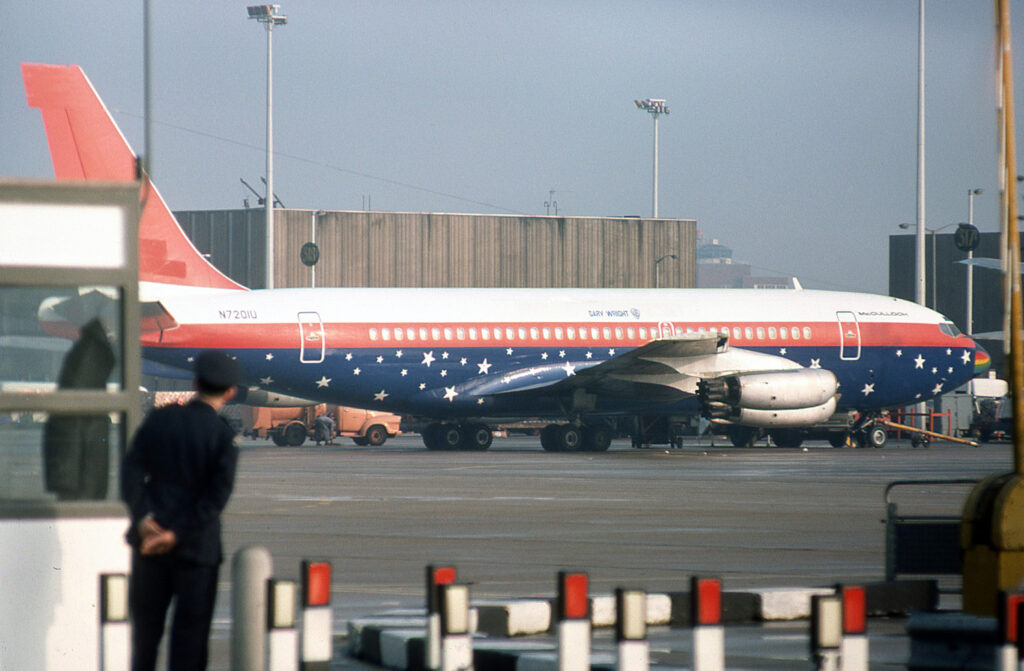
By November 1976 with the Frampton tour dying down, the plane was flown back to Canada. Unbeknownst to its crew, that would be the final tour to use the aircraft.
1977: Parked and repossessed
From February 1977 to at least April 1978, The Starship was parked in the open at Long Beach in California, Frampton and Wright’s names still painted on the side.
The continued high cost of fuel meant that the plane had become unaffordable to bands seeking an efficient way to tour.
“It wasn’t so much the maintenance as it was the rising price of fuel that led to selling it,” Sylvester said in the April 2009 issue of Airways magazine.
He gave a similar explanation to the New York Times Magazine in 2003, saying: “’It was hard to make the argument that the Starship’s fuel was part of the national defense,” leaving it at the mercy of higher fuel prices.
The plane had also now been flying for 18 years and the continued mechanical issues were causing frustration to rock bands’ tight schedules.
With the plane out of the air and no revenue coming in, Contemporary Entertainment Services had a serious financial problem. On February 25, 1977, the company breached the conditions of its $650,000 loan from Bank Of America, a certificate of repossession stored by the FAA says.
Desperate to bring in more revenue, Sylvester came up with a bizarre scheme to partner with the California Avocado Advisory Board and place more than 10 articles in newspapers across the US that promoted the luxury plane through avocado recipes purportedly served on board by the plane’s chef Siegfried Daniel.
According to the articles, Daniel regularly served rockstars avocado soufflé, guacamole, avocados with seafood and even an avocado “pie”.
“Many of the people who are guests on Starship One prefer light and uncomplicated food while on the road,” an article published in The Mobile Register on March 24, 1977 read.

It seems unlikely that Daniel existed. Instead, he seems to have been an invention created for the promotional campaign. No other articles about the plane mention Daniel, despite other crew members such as stewardess Suzee Carnel being named repeatedly in the press at the time.
The outlandish avocado scheme didn’t work, however. With no payments on the promissory note being made, Bank of America repossessed The Starship’s four engines on November 10, 1977.
By May 17, 1978, Bank Of America had taken possession of the entire plane, registering with the FAA as its new owner.
Bank Of America now searched for a new owner for this ageing plane. Who would buy this bizarre aircraft with its crimson bar and Frampton’s name still painted on the outside? The bank’s answer came in the form of colourful Seattle businessman Arthur Joël Eisenberg, who bought the plane on June 21, 1978 and had it flown to Seattle.
1978: Aeroamerica buys The Starship
Since 1971, Eisenberg and his then-wife June had operated a series of aviation businesses. He bought five Boeing 720 planes in 1973 alone, later finding novel uses for them.
One plane bought that year was later rented to ABC, which was filming the 1981 made-for-television film “Jacqueline Bouvier Kennedy”. One side of the plane was repainted as Air Force One, for which Eisenberg received $8,900, court filings show. The plane was later scrapped for $49,350.
Eisenberg’s airline, which operated under the name Aeroamerica was scrappy, a far cry from the professionalism of United Airlines.
“Our contract maintenance was in Tel Aviv with Bedek Aviation/IAI,” flight engineer Gary Winstead explained in an interview published on the OldJets website. “You couldn’t take an airplane that carried EgyptAir, Saudia, or especially Libyan Arab titles on the side to Tel Aviv.”
“So we would fly in by canceling over the Turkish coast, refilling in Nicosia and landing under cover of darkness and taxiing straight to the end of the runway and into Bedek/IAI’s hangar,” he explained. “Of course the Israelis were already expecting us so when we got in the hangar tarps were put over the logo and workers removed all logo cups, briefing cards etc from the aircraft. We would just reverse everything to leave but the first time you did it, it was a little scary!”
Eisenberg refitted The Starship, removing the garish interior and painting over the blue, red and white design. By August 1978, it had a new plain white colour scheme with a red cheat line, the model of a for-hire private jet perfect for businesses looking to take their executives overseas.
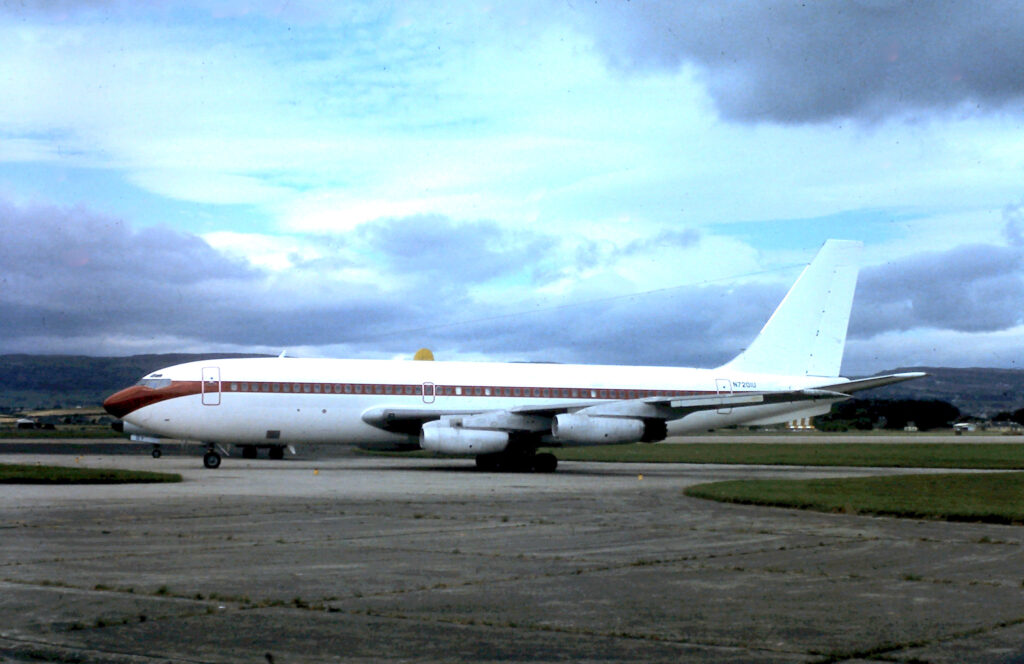
Keen to make as much money from the plane as possible, Eisenberg leased it to Private Jet Services which put The Starship into service as a corporate charter jet. It was regularly spotted across Europe, spending many hours in the sky between the UK and continental Europe.
1979: Starship the corporate jet
Unlike the rockstars of previous years, the businesses chartering the plane in 1979 didn’t invite photographers on board, so it’s difficult to track who used the plane during this period.
We do know the identity of one client however: The government of Guinea. In February 1979, the plane was seen at Heathrow in the UK with black titles on the side that read “Republique Populaire Revolutionnaire De Guinee”.
However, part of the titles seems to have peeled off, leaving the final two words obscured and causing decades of speculation that the plane may have secretly been rented by Iran. We investigate this period of the plane’s history in this article.
These corporate customers leasing the plane through Private Jet Services wasn’t enough to keep Eisenberg’s business afloat, however. Aeroamerica was in financial distress and by November 1979 had filed for bankruptcy and voluntarily suspended operating its own flights.
Documents stored by the FAA show that Eisenberg was using The Starship as security for various financial deals, offering it as security to Conex Aviation of Nassau, Bahamas on June 5, 1979 and then also offering the plane up as security to the State of Washington Attorney General on August 31, 1979, likely in connection with a $140,000 fine the company was given in a fraud case.
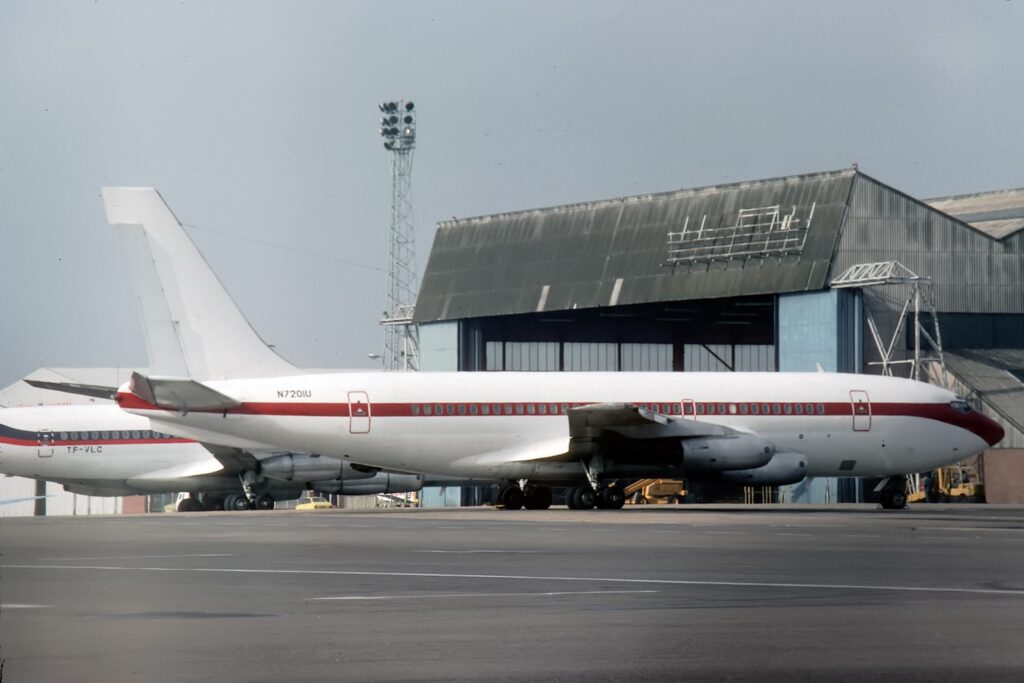
Winstead explained in an article for LedZepNews that he was on board the plane’s final flight from Basel to Luton at some point in 1979.
“I meet up with a crew I had never meet before. The captain informed me we we’re going to Luton for a maintenance check. We dropped the Starship at Luton and I bummed a jumpseat back to Berlin,” he wrote.
“At some point before November 1979, I was supposed to pick up the Starship and fly her to Boeing Field. The short story here is it never happened as the mechanics found too much corrosion in the tail and somewhere else to fly it anywhere,” he continued.
1980-1982: Parked and broken up
The Starship’s future was again uncertain. Beginning in February 1980, the plane was stored in the open at Luton airport in the UK. The Starship sat on the engine bay with its tail folded over, visible to curious passengers of other flights.
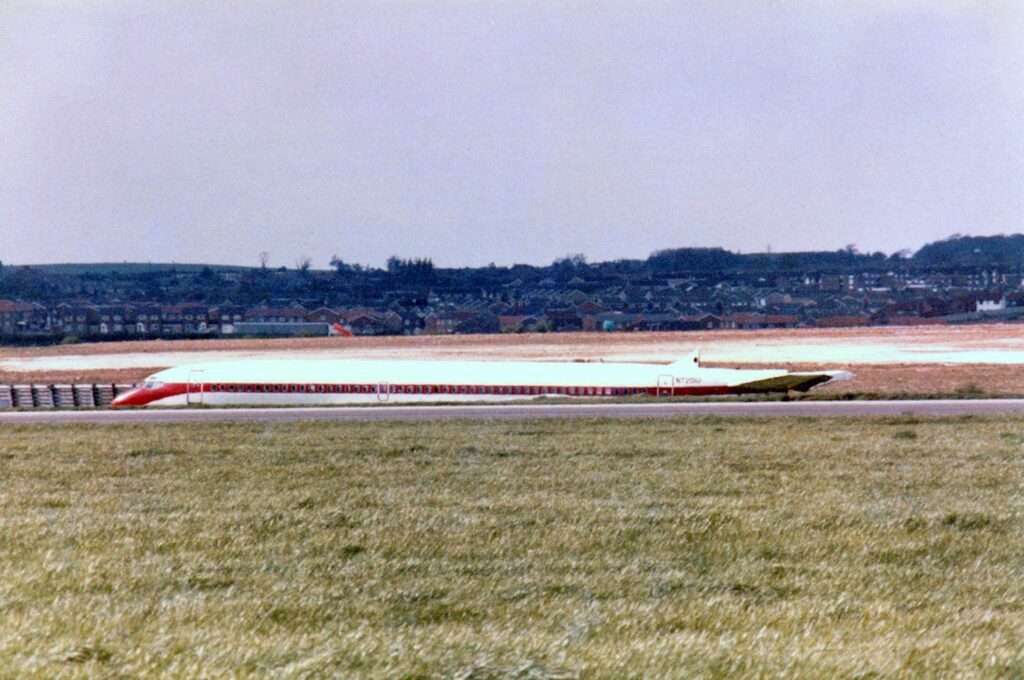
A glimmer of hope came when a Middle Eastern airline expressed an interest in buying the ageing plane. It was discovered that the plane was too corroded to sell.
The plane was last seen in a photograph published on Flickr dated June 4, 1982. Its tail had been unfolded, perhaps ready for the plane to be dismantled.
Records stored by the FAA include the plane’s final change of ownership. One June 14, 1982, Eisenberg signed paperwork selling the plane to Turks Holdings, a business based at a PO Box in Nassau in The Bahamas.

From July 13 to July 17, The Starship was broken up for parts in the UK. This plane that had seen so much musical history including John Paul Jones playing music hall songs on its organ, Keith Richards frantically snorting drugs in a storm and Stevie Wonder surprising Elton John, was gradually ripped to pieces and sold off for scrap.
Aeroamerica collapsed, this time for good, at the end of 1982. Eisenberg abandoned his aviation focus, switching to running premium phone lines and sex chat lines later in life. His second wife sued him in 1992, alleging that he had tapped her phones.
In 2010 Eisenberg pled guilty to willfully filing a false individual income tax return after the US government discovered he had been storing millions of dollars overseas since 1983.
2024: The Starship flies again?
That’s it as far as the history of The Starship plane goes. But as we were reporting this story, we discovered a curious coda.
The plane’s tail number N7201U, which stayed the same from 1959 to 1982, is currently registered with the FAA. In fact, this was a brand new reservation made in 2018.
Could The Starship’s tail number be about to return to the skies? We reached out to its new owner, who wished to remain anonymous.
“It’s not a coincidence that I have the N Number of The Starship,” he said via email to LedZepNews.
“I’ve been a Led Zeppelin fan for a long time and for me also being a pilot it is the ultimate to have the ‘license plate’ from the very famous jet which no longer exists and which I can also register on another plane.”
The tail number isn’t currently in use, but the new owner hopes to see it on a rock band’s plane in the future.
“It kind of deserves to be on an aircraft that’s both more than I can afford and with someone that would do it proud – like a current rock band who own a jet and can then call it the ‘new’ Starship,” he said.
Here’s our full timeline of The Starship:
April 16, 1958: United Airlines reserves the tail number N7201U in a letter to the US Department of Commerce (Source: FAA plane records)
November 12, 1959: Boeing applies to register the plane with the CAA (Source: FAA plane records)
November 20, 1959: Plane inspected and confirmed as airworthy by the CAA. Plane was new and had not been flown (Source: FAA plane records)
November 23, 1959: Made its first flight in Renton, Washington. Painted in black, grey and white colour scheme with red “Boeing 720” titles (Sources: This Day In Aviation, eBay photo)
January 15, 1960: Plane inspected and confirmed as airworthy by the CAA. Plane had been flown for 43 hours and 31 minutes (Source: FAA plane records)
February 15, 1960: The CAA confirms the registration of the plane to Boeing (Source: FAA plane records)
March 18, 1960: Plane inspected and confirmed as airworthy by the CAA. Plane had been flown for 97 hours (Source: FAA plane records)
May 9, 1960: Plane inspected and confirmed as airworthy by the CAA. Plane had been flown for 166 hours and 11 minutes (Source: FAA plane records)
May 19, 1960: Plane inspected and confirmed as airworthy by the CAA. Plane had been flown for 188 hours and 45 minutes (Source: FAA plane records)
October 1, 1960: Sold by Boeing to United Airlines, named “720 Jet Mainliner Walter T. Varney”, United Airlines applies to register the plane with the CAA. Repainted with blue, grey and white colour scheme with “United” titles, CAA approves plane’s airworthiness and notes plane had been flown for 296 hours and 38 minutes (Source: FAA plane records)
October 24, 1960: The CAA confirms the registration of the plane to United Airlines (Source: FAA plane records)
1961: Renamed “720 Jet Mainliner Capt. F. M. Crismore”
January 1967: Seen in San Francisco (Source: Bill Larkins on Flickr)
April 18, 1968: Plane inspected by Boeing in Wichita, Kansas and approved by the FAA to return to service (Source: FAA plane records)
September 25, 1969: United Airlines applies to register the plane with the FAA (Source: FAA plane records)
September 17, 1970: Seen in New York (Source: AirHistory)
August 14, 1972: Contemporary Entertainment applies to the Civil Aeronautics Board for permission to operate a Boeing 720 plane to transport music groups (Source: Civil Aeronautics Board Reports, Volume 60)
August 24, 1972: Capitol International Airways files an objection to Contemporary Entertainment’s application (Source: Civil Aeronautics Board Reports, Volume 60)
September 6, 1972: McCulloch International Airlines files an objection to Contemporary Entertainment’s application (Source: Civil Aeronautics Board Reports, Volume 60)
November 28, 1972: Contemporary Entertainment given exemption by the Civil Aeronautics Board to operate the plane. Limited to 100 flight hours per year, charging no less than $2,000 per flight hour, interstate service only (Source: Civil Aeronautics Board Reports, Volume 60)
January 15, 1973: Sold by United Airlines to Contemporary Entertainment for $720,000, renamed “Starship 1”, Contemporary Entertainment applies to register the plane with the FAA, Contemporary Entertainment offers the plane as security for a $650,000 loan with Bank of America (Source: FAA plane records)
March 1973 – June 1973: Interior refit designed by David E. Bell and carried out by World Air Center in Oakland. Stored at McCarran Airport in Las Vegas, Nevada. Repainted with gold and brown colour scheme. (Sources: FAA plane records, Contemporary Entertainment brochure)
- March 26, 1973: Electric wiring for overhead passageway light, cable installation for Flitefone FM communications system carried out
- March 27, 1973: Electric wiring for vanity area and aft RH lavatory carried out
- March 29, 1973: Electric wiring for shower water heater installation carried out
- April 3, 1973: Aft cabin A/C power distribution installed
- April 22, 1973: Leland 60Hz power inverter installed
- May 10, 1973: Fluorescent lighting in bar installed
- May 11, 1973: Modified PSU functions installed, aft passenger address controls and component box relocated
- May 20, 1973: End table lamps and switches in bedroom installed
- May 25, 1973: Starboard emergency light power pack and aft emergency light switch relocated
- May 26, 1973: Passenger entertainment rack modified
- May 27, 1973: Power control and distribution for bar installed
- June 1, 1973: Six duplex power outlets installed
- June 2, 1973: Wiring for two TV monitors and one VCR machine installed
- June 3, 1973: Two TV monitors and VCR machine installed
- June 4, 1973: Dival isle lights relocated
- June 7, 1973: Electric placards installed
- June 8, 1973: Electrical load analysis, stress analysis
- June 10, 1973: Emergency exit light relocated
June 22, 1973: Plane inspected by World Air Center in Oakland and approved to return to service by the FAA (Source: FAA plane records)
Plane flown to Los Angeles for an open house event. The Monkees attend and Baron Hilton inspects the plane.
June 1973: Plane viewed by Steve Weiss and Mark London on behalf of Led Zeppelin at Newark Airport (Source: “Trampled Under Foot” by Barney Hoskyns)
July 11, 1973: Plane inspected by World Air Center in Oakland and approved to return to service by the FAA (Source: FAA plane records)
July 6, 1973 – July 24, 1973: Led Zeppelin use the plane for the second leg of its 1973 US tour. Plane given “Led Zeppelin” titles.
- Likely July 9: Flies from Chicago to Saint Paul. Led Zeppelin’s first flight on The Starship
- July 17, 1973: Flies from New Jersey to Seattle
- July 24, 1973: Flies from New York to Pittsburgh early evening
- July 24, 1973: Flies from Pittsburgh to New York late night
July 16, 1973: Contemporary Entertainment given permission to operate flights to Canada for the next two years (Source: Civil Aeronautics Board Weekly Summary of Orders and Regulations, Issue 29; Issue 73)
August 15, 1973 – October 21, 1973: Used by Elton John. Plane given “Elton John – 1973 Tour” titles.
- September 25, 1973: Flown from New York to Boston with Stevie Wonder on board as a surprise for Elton John. Ira Tucker also on board (Source: Elton John website, Esquire April 1, 1974)
- October 1, 1973: Seen at Atlanta airport (Source: JetPhotos)
Likely September 3, 1973: Plane hired by MGM and flown from Los Angeles to San Francisco to promote Judi Pulver’s debut album. Astronaut Edgar Mitchell was on board (Sources: Newsweek October 27, 1975, Record Week September 29, 1973, Record Week September 8, 1973)
September 14-15, 1973: Used by Sonny and Cher to fly to Nashville, seen in Los Angeles. Plane given Sonny and Cher logo (Sources: Ron Monroe on Flickr, Amusement Business September 22, 1973)
October 24, 1973 – November 8, 1973: Used by The Moody Blues
Possibly used by The Allman Brothers Band
December 8, 1973 – December 26, 1973: Used by Alice Cooper. Plane eventually given “Alice Cooper” titles and logo on tail. Band paid $35,000 (Source: “Billion Dollar Baby – On Tour with Alice Cooper” by Bob Greene)
- First flight was meant to be from Nashville to Greensboro on the morning of December 9, 1973 but was cancelled as The Allman Brothers Band still had the plane following raining off of their December 9, 1973 Tampa show (Source: “Billion Dollar Baby – On Tour with Alice Cooper” by Bob Greene)
- December 10, 1973: Flew from Piedmont to Madison (Source: “Billion Dollar Baby – On Tour with Alice Cooper” by Bob Greene)
- December 12, 1973: Flew from Madison to Ann Arbor. Cold weather froze one of the jet valves. James Randi , Chris Charlesworth and Cybill Shepherd were on board. Plane not yet repainted with Alice Cooper titles (Source: “Billion Dollar Baby – On Tour with Alice Cooper” by Bob Greene, Chris Charlesworth)
- December 15, 1973: Flown from Toronto to Syracuse. 1972 film “Give Me A Sailor” was screened on board (Source: “Billion Dollar Baby – On Tour with Alice Cooper” by Bob Greene)
- December 16, 1973: Flown from Syracuse to Norfolk, Virginia (Source: “Billion Dollar Baby – On Tour with Alice Cooper” by Bob Greene)
- December 17, 1973: Flown from Norfolk to Baltimore. Alice Cooper not on board. Snowstorm caused airport delays and something had struck the plane’s tail during the night (Source: “Billion Dollar Baby – On Tour with Alice Cooper” by Bob Greene)
- December 20, 1973: Flown from Baltimore to Tampa, Florida at 3pm. Plane now repainted. Flight delayed from the early morning as it needed an engine part (Source: “Billion Dollar Baby – On Tour with Alice Cooper” by Bob Greene)
- Likely December 22-23: Flown from Tampa, Florida to New York (Source: “Billion Dollar Baby – On Tour with Alice Cooper” by Bob Greene)
- Tour stopped using The Starship by December 26 because of delays (Source: “Billion Dollar Baby – On Tour with Alice Cooper” by Bob Greene)
January 3, 1974 – February 14, 1974: Used by Bob Dylan. No titles on plane. Paid $20,000 (Sources: “Bob Dylan: An illustrated discography” by Stuart Hoggard, Rolling Stone January 31, 1974)
March 1, 1974 – April 9, 1974: Used by Deep Purple. Plane given “Deep Purple” titles
- Flown from New York to Boston (Source: The New Yorker April 15, 1974)
- April 9, 1974: Flown from Los Angeles to San Diego (Source: NME magazine April 27, 1974)
- April 9, 1974: Flown from San Diego to Los Angeles. Party on board to mark the end of the tour (Source: NME magazine April 27, 1974)
June 1, 1974 – August 24, 1974: Used by The Allman Brothers Band. Plane given “Allman Brothers Band” titles.
- June 1, 1974: Flown from Macon to Atlanta (Source: “Midnight Riders: The Story of the Allman Brothers Band” by Scott Freeman)
- July 30, 1974: Seen at Atlanta (Sources: Airliners and Wikimedia Commons)
August 31, 1974: Possibly used by Deep Purple to fly to Los Angeles (Source: Glenn Hughes: The Autobiography)
September 24, 1974 – December 3, 1974: Used by Elton John (unclear when he stopped using it). Plane repainted with red, white and blue colour scheme and given “Elton John Band Tour 1974” titles.
- September 24, 1974: Flown from Los Angeles to New Orleans (Source: “His Song: The Musical Journey of Elton John” by Elizabeth J Rosenthal)
- October 1974: Seen at Boeing Field (Source: Bob Harrington on Flickr)
- November 1974: Flown from New York to Boston. Joined on board by John Lennon (Sources: Elton John website, Boston Globe)
November 13, 1974 – December 18, 1974: Used by Deep Purple (unclear when they began using it). Plane given “Deep Purple” titles.
January 17, 1975 – March 27, 1975: Led Zeppelin use plane for 1975 US tour. Plane given “Led Zeppelin” titles.
- January 17, 1975: Flown from Chicago to Minneapolis for tour rehearsals (Source: “LZ-’75” by Stephen Davis)
- Evening of January 18, 1975: Flown from Minneapolis to Chicago (Source: “LZ-’75” by Stephen Davis)
- Between January 18, 1975 and January 24, 1975: Likely flown from Chicago to Cleveland
- Evening of January 24, 1975: Flown from Cleveland to Chicago. Blizzard caused pilot to advise not flying until he was given cocaine by Peter Grant (Sources: “Led Zeppelin: The Biography” by Bob Spitz, “LZ-’75” by Stephen Davis)
- January 25, 1975: Flown from Chicago to Indianapolis (Source: “LZ-’75” by Stephen Davis)
- Evening of January 25, 1975 or January 26, 1975: Flown from Chicago to Los Angeles. Robert Plant stayed in Chicago as he was unwell. John Bonham sexually assaults one of the stewardesses during the flight. Chris Charlesworth was allowed to fly the plane briefly. Chris Charlesworth was on board along with Cameron Crowe and Neal Preston (Sources: “LZ-’75” by Stephen Davis, “Led Zeppelin: The Biography” by Bob Spitz, “Hammer Of The Gods” by Stephen Davis, Chris Charlesworth)
- Morning of January 29, 1975: Flown from Los Angeles to Greensboro. Chris Charlesworth was on board (Sources: “LZ-’75” by Stephen Davis, Chris Charlesworth)
- Evening of January 29, 1975: Flown from Greensboro to New York. Chris Charlesworth was on board along with Atlantic Records staff (Sources: “LZ-’75” by Stephen Davis, Chris Charlesworth)
- Evening of January 31, 1975: Flown from New York to Detroit (Source: “LZ-’75” by Stephen Davis)
- Evening of January 31, 1975: Flown from Detroit to New York. Danny Marcus was on board and had his glasses destroyed by John Bonham (Source: “LZ-’75” by Stephen Davis)
- February 1, 1975: Likely flown from New York to Pittsburgh
- Between February 1, 1975 and February 6, 1975: Likely flown from Pittsburgh to New York
- February 6, 1975: Flown from New York to Montreal (Source: “LZ-’75” by Stephen Davis)
- Between February 6, 1975 and February 10, 1975: Likely flown from Montreal to New York
- February 10, 1975: Flown from New York to Baltimore (Source: “LZ-’75” by Stephen Davis)
- Between February 10, 1975 and February 12, 1975: Likely flown from Baltimore to New York
- Possibly February 15, 1975: Flown from New York to New Orleans (Source: “Led Zeppelin: The Biography” by Bob Spitz)
- February 16, 1975: Flown from New Orleans to St. Louis (Source: “Led Zeppelin: The Biography” by Bob Spitz)
- February 16, 1975: Flown from New York to St. Louis (Source: “LZ-’75” by Stephen Davis)
- Evening of February 16, 1975: Flown from St. Louis to New York (Source: “LZ-’75” by Stephen Davis)
- February 28, 1975: Flown from Baton Rouge to New Orleans (Source: “LZ-’75” by Stephen Davis)
- Evening of March 5, 1975: Flown from Dallas to New Orleans. Jimmy Page, Robert Plant and Peter Grant on board. John Paul Jones and John Bonham stayed in Dallas. (Source: “LZ-’75” by Stephen Davis)
- Between March 6, 1975 and March 10, 1975: Likely flown from New Orleans to Los Angeles
- March 10, 1975: Flown from Los Angeles to San Diego. Nick Kent and Danny Goldberg on board. Flown in storm. (Source: “LZ-’75” by Stephen Davis)
- Evening of March 10, 1975: Flown from San Diego to Los Angeles in storm. (Source: “LZ-’75” by Stephen Davis)
- March 14, 1975: Flown from Los Angeles to San Diego. Billy Connolly on board (Source: “LZ-’75” by Stephen Davis)
- Evening of March 14, 1975: Flown from San Diego to Los Angeles (Source: “LZ-’75” by Stephen Davis)
- March 16, 1975: Flown from Los Angeles to Seattle (Source: “LZ-’75” by Stephen Davis)
- March 19, 1975: Flown from Seattle to Vancouver (Source: “LZ-’75” by Stephen Davis)
- Morning of March 21, 1975: Flown from Vancouver to Seattle (Source: “LZ-’75” by Stephen Davis)
- Between March 22 and March 24, 1975: Flown from Seattle to Los Angeles
April 1, 1975 – May 23, 1975: Used by John Denver. Plane given “John Denver” titles.
June 1, 1975 – August 8, 1975: Used by The Rolling Stones. Plane given “Tour Of The Americas 75” titles and logo (Source: Getty Images)
- June 6, 1975: Plane was flown to Kansas (Source: Getty Images)
- June 9, 1975: Flown to St. Paul (Source: “T.O.T.A. ’75: The Rolling Stones Tour of the Americas, 1975” by Christopher Simon Sykes)
- Evening of June 9, 1975: Flown from St. Paul to Boston. Bill Wyman beats Christopher Simon Sykes at backgammon (Source: “T.O.T.A. ’75: The Rolling Stones Tour of the Americas, 1975” by Christopher Simon Sykes)
- June 18, 1975: Flown from Toronto to New York around midnight. Mick Jagger starts a food fight on board (Source: “T.O.T.A. ’75: The Rolling Stones Tour of the Americas, 1975” by Christopher Simon Sykes)
- Likely July 3 or 4, 1975: Flown from Washington DC to Memphis in a thunderstorm (Source: “Ronnie” by Ronnie Wood)
- July 6, 1975: Flown to Dallas, Texas (Source: WFAA Collection film)
July 25, 1975: Leased for at least 6 months by McCulloch International Airlines
July 31, 1975: An application by Contemporary Entertainment Services was dismissed by the Civil Aeronautics Board (Source: Weekly Summary of Orders and Regulations August 1-7, 1975)
September 29, 1975 – October 26, 1975: Used by Elton John. Plane given “Elton John Rock Of The Westies” titles.
- October 1975: Seen in Las Vegas (Source: Paul Thallon on Flickr)
November – December 1975: Used by The Allman Brothers Band
January 12, 1976: Seen in Manchester, UK
February 23, 1976: Plane inspected by Braniff Airways in Dallas, Texas and McCulloch International Airlines in California and approved to return to service by the FAA (Source: FAA plane records)
March 1, 1976 – April 6, 1976: Used by Olivia Newton-John. Plane given “Olivia Newton-John” titles. (Source: Aero Icarus on Flickr)
June 1976: Seen at Long Beach with no titles (Source: Ron Monroe on Flickr)
June 29, 1976 – August 17, 1976: Used by Elton John. Plane given “Elton John – Louder Than Concorde But Not Quite As Pretty” titles.
- August 4 – Flown from Cincinnati to Chicago. Elton John insisted the crew stock up on KFC (Source: Chris Charlesworth)
October 16, 1976: Plane inspected by McCulloch International Airlines in California and approved to return to service by the FAA (Source: FAA plane records)
October 8, 1976 – November 8, 1976: Used by Peter Frampton and Gary Wright for US and UK tour. Plane given “Frampton Comes Alive” (starboard) and “Gary Wright” (port) titles.
- October 24, 1976: Flew from Heathrow to Manchester (Source: John Oram on Flickr)
- October 30, 1976: Seen at Heathrow (Source: Paul Thallon on Flickr)
- October 1976: Seen at Frankfurt (Source: Aero Icarus on Flickr)
- November 4, 1976: Seen at München-Riem (Source: Munich-Riem Aviation Photos on Flickr)
- November 1976: Seen at Düsseldorf (Source: Uli on Flickr)
- Seen at Hamburg (Source: A Flying History)
November 12, 1976: Flown from Heathrow to Gander, Canada
January 21, 1977 – June 26, 1978: Returned from lease, stored at Miami International
February 1977: Seen at Long Beach (Source: Airliners)
February 25, 1977: Contemporary Entertainment defaults on its $650,000 loan from Bank Of America (Source: FAA plane records)
July 1977: Seen at Long Beach (Source: Ron Monroe on Flickr)
September 23, 1977: Seen at Long Beach (Source: AirHistory)
November 10, 1977: Engines repossessed by Bank of America. Seen at Long Beach (Source: FAA plane records)
April 1978: Seen at Long Beach (Source: Ron Monroe on Flickr)
May 17, 1978: Bank Of America applies to register the plane with the FAA (Source: FAA plane records)
June 21, 1978: Sold by Bank Of America to Aero America. Delivered to Boeing Field (Source: FAA plane records)
June 28, 1978: Aero America applies to register the plane with the FAA (Source: FAA plane records)
July 1978: Seen in US with “Frampton Comes Alive” and “Gary Wright” titles (Source: AirHistory)
July 31, 1978: Seen at Boeing Field with red cheat line, EO titles and logo
August 1, 1978: Seen at Boeing Field
August 26, 1978: Seen in the UK without EO titles
August 31, 1978: Seen at Glasgow
September 2, 1978: Seen at Glasgow with red cheat line, white paint scheme, no titles (Sources: Paul Thallon on Flickr, Fergus Abraham on Flickr)
September 4, 1978: Flew from Heathrow to Shannon to Bangor (Source: Malcolm Nason on Flickr)
September 1978: Seen at Tegel with no titles (Source: Planeboys.de)
September 25, 1978: Seen at Tegel with no titles
October 26, 1978: Seen at Inverness (Source: Air Pictorial Volume 41)
October 26, 1978: Flew Cairo to Aberdeen Inverness to Berlin. Possibly for delivery to Private Jet Services
October 31, 1978: Seen at Inverness (Source: Air Pictorial Volume 41)
Late 1978: Flew from Tegel to Rome carrying actor Omar Sharif
November 1978: Flew from Basel to Mulhouse (Source: Airliners)
January 7, 1979: Seen at Heathrow (Source: Kerry Taylor on Flickr)
February 14, 17, 21 1979: Visited Heathrow with executive configurement wearing “Republique Populaire Revolutionnaire Guinee” titles and used by the government of Guinea (Source: Transportphotos)
February 22, 1979: Seen at Heathrow with no titles
March-April 1979: Seen at Salisbury, Rhodesia with no titles
March 30, 1979: Seen at Luton (Source: Air Yorkshire April 1979)
March 1979: Returned to Aero America
April 1, 1979: Seen at Stansted
May 1979: Seen at Paris Charles de Gaulle Airport with red cheat line, no titles
June 5, 1979: Plane is offered as security by Aero America to Conex Aviation of Nassau, Bahamas (Source: FAA plane records)
August 1979: Seen at Luton with red cheat line, no titles (Source: AirHistory)
August 31, 1979: Plane is offered as security by Aero America to the State of Washington Attorney General (Source: FAA plane records)
September 1, 1979: Seen at Heathrow (Source: Air Yorkshire September 1979)
September 5, 1979: Seen at Luton with red cheat line, no titles. (Source: ABPic)
September 8, 1979: Seen at Luton with red cheat line, no titles (Source: prs1958 on Flickr, treadigraph on PPRuNe)
September 9, 1979: Seen at Luton (Source: AirHistory)
September 12, 1979: Seen at Luton with red cheat line, no titles (Source: Air Yorkshire October 1979)
November 9, 1979: Aeroamerica surrenders its operating certificate to the FAA
November 19, 1979: Aeroamerica files for bankruptcy
February 10, 1980: Stored at Luton. Sat on the engine run bay with tail folded
March 5, 1980: Seen at Luton (Source: Teesside Aviation News April 1980)
April 29, 1980: Open storage at Luton (Source: Air Yorkshire May 1980)
September 1980: Moved to Luton maintenance area
December 29, 1981: Flown to Oakland and worked on for an Arab customer till it was found to be riddled with corrosion.
March 1982: Impounded at Oakland by World Airways due to unpaid parking charges (Source: Mike Zoeller)
May 1982: Released and flown to Luton.
May 3, 1982: Seen at Luton with red cheat line, no titles. Tail folded (Source: Kerry Taylor on Flickr)
June 4, 1982: Seen at Luton with red cheat line, no titles. Had a tail (Source: Kerry Taylor on Flickr)
June 14, 1982: Sold by Aero America to Turks Holdings in Nassau, Bahamas (Source: FAA plane records)
July 13-17, 1982: Broken up at Luton. Some parts used for OY-DSK Boeing 720-025 (Source: Mike Zoeller)
With thanks to: Mike Zoeller, Eric Levy, Chris Charlesworth, Bob Hobbs, Paul Thallon and Fergus Abraham.

Is there a BOOK WITH PICTURES that you can buy.
I love the story of this plane and have followed it.
It’s really sad what happened to an important part of Rock history.
Please let me know
What wonderful research! Thank you for all your work and publishing it here! (I agree with the other commenter that this would make a good illustrated book!)
It was fun till the end…but over the years she had gotten a little rough inside and out. I flew the last trip Basel to Luton.
Tremendous work! Thanks for the incredible history and extraordinary detail!
Any news yet of a Illustrated book???